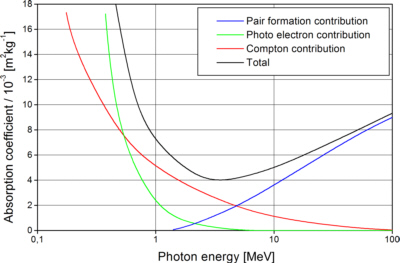Al atravesar la materia, los rayos X son absorbidos. Si un haz de rayos X de intensidad I atraviesa un absorbente de espesor x con un coeficiente de absorción lineal µ(E) dependiente de la energía del fotón, la pérdida de intensidad será, en buena aproximación, proporcional a la intensidad y al espesor del absorbente:

Integrando esta expresión se obtiene la parte I(x) de la intensidad incidente I0 que se encuentra detrás del absorbedor:

El coeficiente de absorción lineal µ está correlacionado con el coeficiente de absorción β mediante
![]()
donde β (valores listados, por ejemplo) es la parte imaginaria del índice de refracción complejo n*:

En la absorción de rayos X intervienen tres efectos: el efecto Compton, el efecto fotoeléctrico y la producción de pares. Cada uno de ellos contribuye a la sección transversal de absorción σtotal , que da la probabilidad de que un fotón interactúe al atravesar un determinado espesor de materia:

En la mayoría de las aplicaciones ópticas de rayos X en las que se utilizan energías de fotones inferiores a 1 MeV, la mayor parte de la absorción es fotoeléctrica.

Fig. 1: El coeficiente total de absorción de masa para el Pb con las contribuciones de la absorción fotoeléctrica, la dispersión Compton y la formación de pares electrón-positrón [Eng 1966]
La absorción fotoeléctrica se produce cuando un fotón de rayos X transfiere energía a un electrón del absorbente. Como los electrones ligados en un átomo muestran niveles de energía discretos, sólo hay ciertas porciones posibles de energía para sufrir transiciones entre los diferentes niveles. Éstos se muestran en la fig. 2.

Fig. 2: Relación entre las energías de enlace de los electrones, el número atómico Z y la transición electrónica: descargar los datos [Hen 1993]
Para los niveles internos, la energía de enlace crece aproximadamente proporcional al cuadrado del número atómico Z. Esto se conoce como la ley de Moseley (Henry Moseley, 1913):

Con la constante de Planck h, la frecuencia f de los fotones absorbidos (o emitidos) durante una transición de un electrón entre los niveles de electrones con los números cuánticos principales m y n, la constante de RydbergRy, el número atómico Z y una constante de apantallamiento K (corrección para tener en cuenta el efecto de apantallamiento de los electrones entre el electrón considerado y el núcleo, apantallando la carga del núcleo). Ry es

con la constante de estructura fina α la longitud de onda ComptonλC,e del electrón.
| [Eng 1966] | H. A. Enge, Introduction to nuclear physics, p. 193, Addison-Wesley, 1966 |
| [Hen 1993] |
B. L. Henke, E. M. Gullikson, and J. C. Davis. X-ray interactions: photoabsorption, scattering, transmission, and reflection at E=50-30000 eV, Z=1-92, Atomic Data and Nuclear Data Tables Vol. 54 (no.2), p. 181-342, July 1993 |
| [Mos 1913] | H. G. J. Moseley, The High Frequency Spectra of the Elements, Phil. Mag., p. 1024, 1913 |


